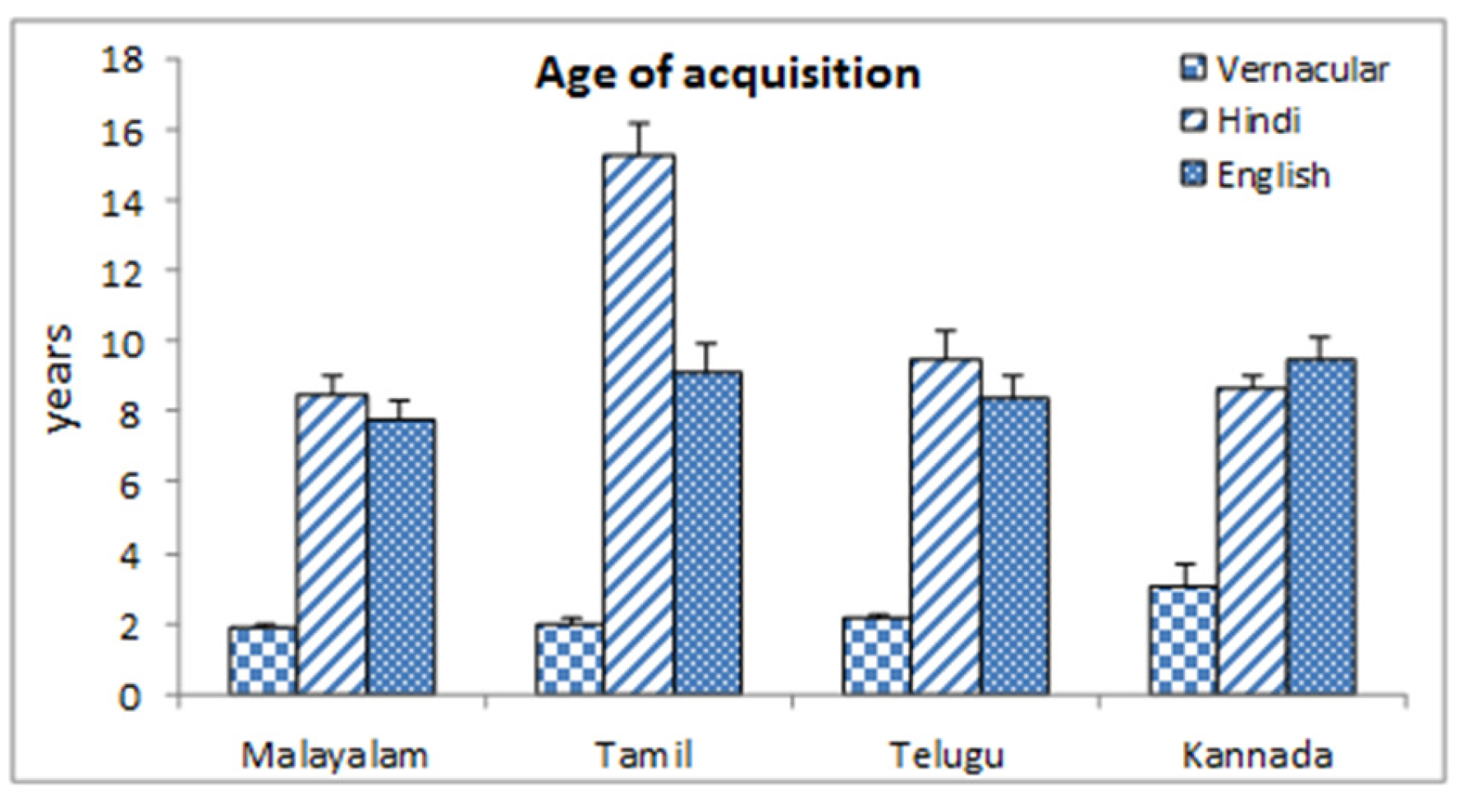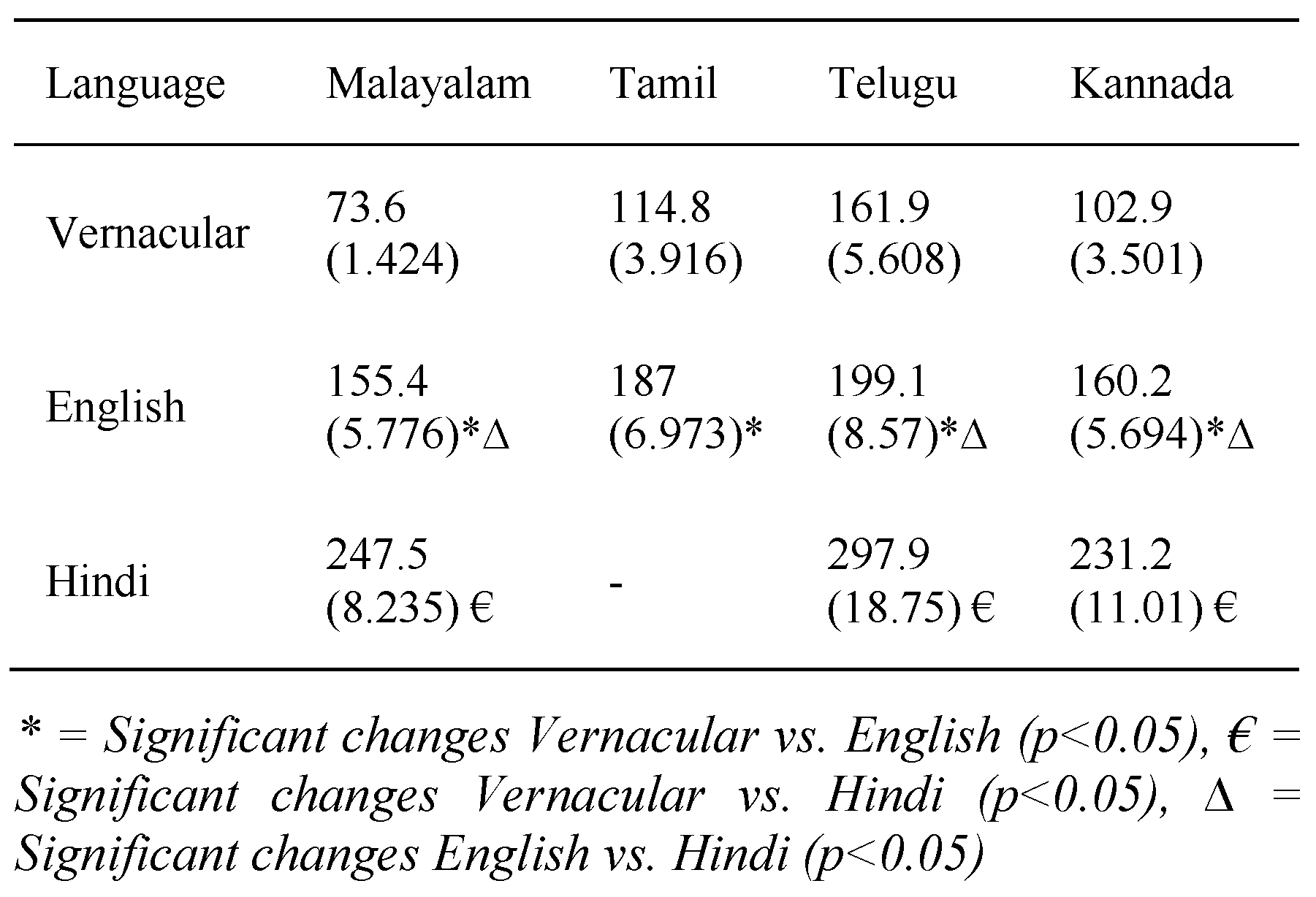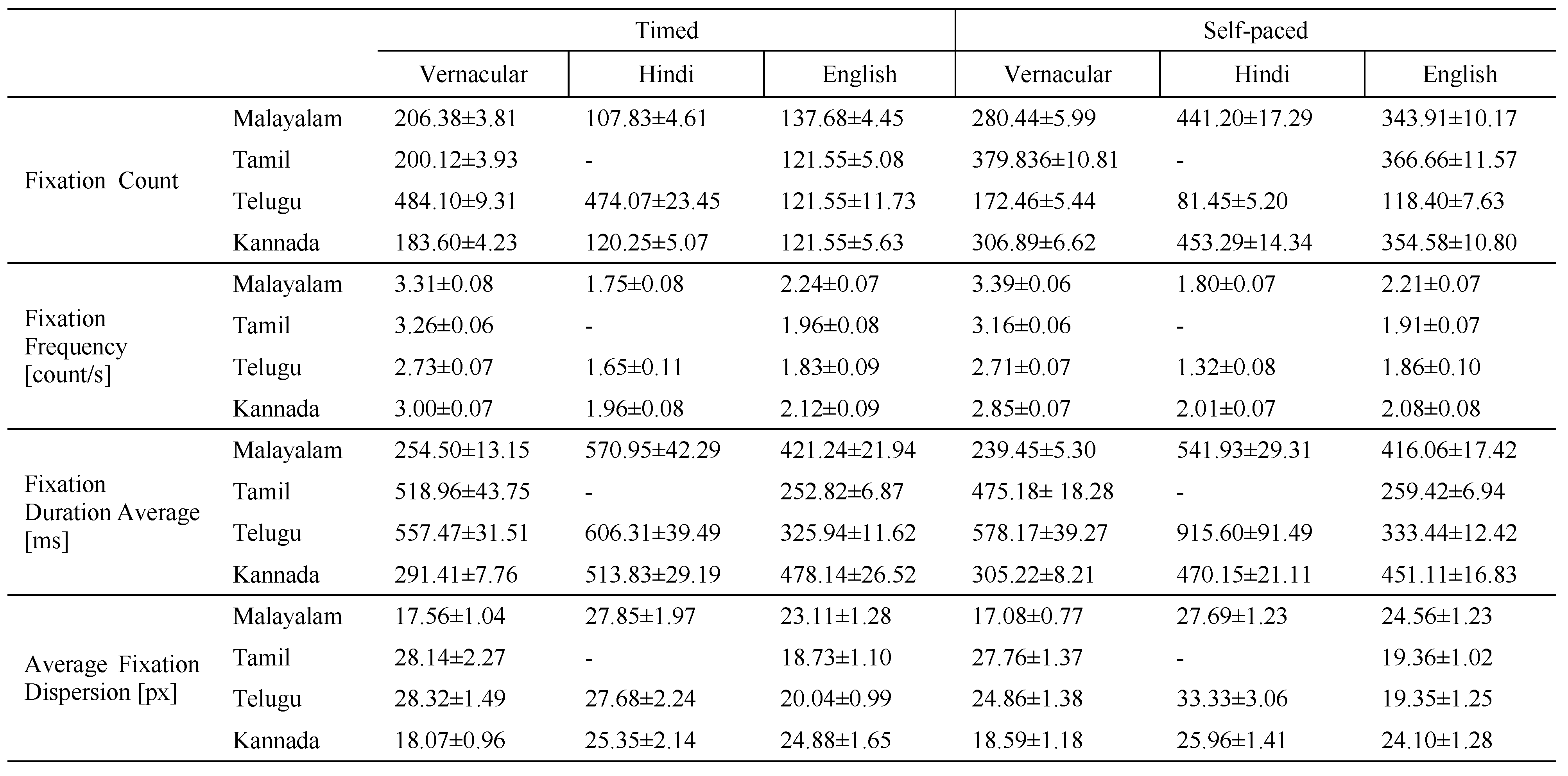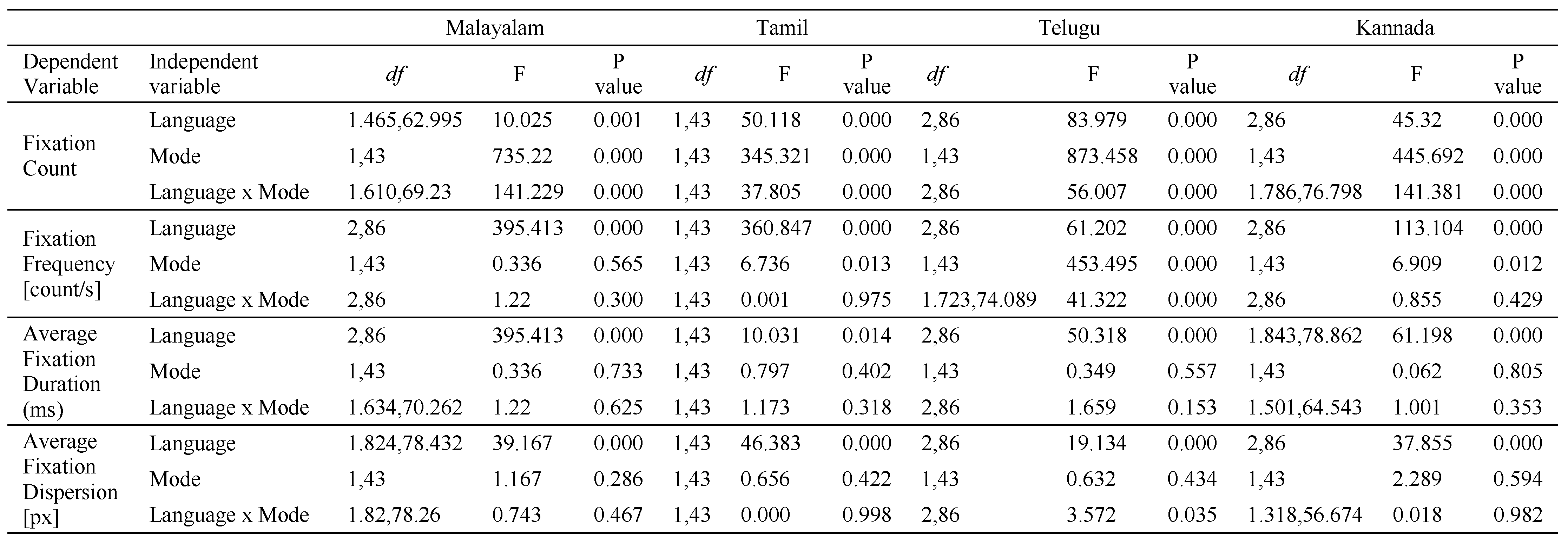Effect of Dravidian Vernacular, English and Hindi During Onscreen Reading Text: A Physiological, Subjective and Objective Evaluation Study
Abstract
:Introduction
Methods
Participants
Experimental protocol
Statistical treatment of the data
Results
Discussion
Conclusion:
Acknowledgments
References
- Altarriba, J., J.F. Kroll, A. Scholl, and K. Rayner. 1996. The influence of lexical and conceptual constraints onreading mixed-language sentences:Evidence fromeye-fixations and reading times. Memory & Cognition 24: 477–492. [Google Scholar]
- Bax, S., and C. Weir. 2012. Investigating learners’ cognitive reading processes during a computer-based CAE reading test. University of Cambridge ESOL Examinations Research Notes 47: 3–14. [Google Scholar]
- Blignaut, P., and T. Beelders. 2009. The effect of fixational eye movements on fixation identification with a dispersion-based fixation detection algorithm. Journal of Eye Movement Research 2, 5: 4, 1–14. [Google Scholar]
- Blumenfeld, H. K., and V. Marian. 2011. Bilingualism influences inhibitory control in auditory comprehension. Cognition 118: 245–257. [Google Scholar] [PubMed]
- Brunner, J. 2010. Bilingual Education and English as a Second Language Programs Summary Report, Z009-Z010. Austin Independent School District, Department of Program Evaluation. See http://archive.austinisd.org/inside/docs/ope_09_67__Bilingual_Education_and_English_as_a_Second_Language.pdf (accessed 29 May 2012).
- Cirilo, R. K., and D. J. Foss. 1980. Text structure and reading time for sentences. Journal of Verbal Learning and Verbal Behaviour 19: 96–109. [Google Scholar]
- Deutsch, A., and S. Bentin. 2001. Syntactic and semantic factors in processing gender agreement in Hebrew: Evidence from ERPs and eye movements. Journal of Memory and Language 45, 2: 200–224. [Google Scholar]
- Dewaele, J.-M. 2004. Edited by M.S. Schmid, B. Kopke, M. Kejser and L. Weilemar. Perceived language dominance and language preference for emotional speech: The implications for attrition research. In First Language Attrition: Interdisciplinary perspectives on methodological issues. Amsterdam/Philadelphia, PA: Benjamins, pp. 81–104. [Google Scholar]
- Encyclopaedia Britannica. 2008. Dravidian languages. Encyclopaedia Britannica Online. Jun. 30. [Google Scholar]
- Declaration of Helsinki. World Medical Association. Available from: http://www.wma.net/e/ethicsunit/helsinki.htm (accessed on 24 June 2008).
- Dussias, P. E., and N. Sagarra. 2007. The effect of exposure on syntactic parsing in Spanish English bilinguals. Bilingualism: Language and Cognition 10: 101–116. [Google Scholar]
- Duyck, W., E. Van Assche, D. Drieghe, and R. J. Hartsuiker. 2007. Visual word recognition by bilinguals in a sentence context: Evidence for non-selective lexical access. Journal of Experimental Psychology: Learning, Memory, and Cognition 33: 663–679. [Google Scholar]
- Ehrlich, S. F., and K. Rayner. 1981. Contextual effects on word perception and eye movements during reading. Journal of Verbal Learning and Verbal Behavior 20: 641–655. [Google Scholar] [CrossRef]
- Felser, C., M. Sato, and N. Bertenshaw. 2009. The on-line application of binding Principle A in English as a second language. Bilingualism: Language and Cognition 12: 485–502. [Google Scholar] [CrossRef]
- Flecken, M. 2011. Event conceptualization by early Dutch-German bilinguals: Insights from linguistic and eye-tracking data. Bilingualism: Language and Cognition 14: 61–77. [Google Scholar]
- Gennari, S., S. Sloman, B. Malt, and T. Fitch. 2002. Motion events in language and cognition. Cognition 83: 49–79. [Google Scholar]
- Godfroid, A., F. Boers, and A. Housen. 2013. Gauging the role of attention in L2 vocabulary acquisition by means of eye-tracking. Studies in Second Language Acquisition 35, 3. [Google Scholar]
- Gollan, T.H., G.H. Weissberger, E. Runnqvist, R.I. Montoya, and C.M. Cera. 2012. Self-ratings of spoken language dominance: A Multilingual Naming Test (MINT) and preliminary norms for young and aging Spanish-English bilinguals. Bilingualism: Language and Cognition 15: 594–615. [Google Scholar] [PubMed]
- Heredia, R. 1997. Bilingual memory and hierarchical models: A case for language dominance. Current Directions in Psychological Science 6: 34–39. [Google Scholar]
- Hyltenstam, K., and N. Abrahamsson. 2003. Edited by K. Fraurud and K. Hyltenstam. Age of onset and ultimate attainment in near-native speakers of Swedish. In Multilingualism in global and local perspectives. Selected papers from the 8th Nordic conference on bilingualism, November 1–3, 2001, Stockholm Rinkeby. Stockholm: Centre for Research on Bilingualism, Stockholm University, and Rinkeby Institute of Multilingual Research, pp. 319–340. [Google Scholar]
- Hyönä, J., and A. Pollatsek. 1998. Reading Finnish compound words: Eye fixations are affected by component morphemes. Journal of Experimental Psychology: Human Perception and Performance 24: 1612–1627. [Google Scholar]
- Juhasz, B.J., and K. Rayner. 2003. Investigating the effects of a set of intercorrelated variables on eye fixation durations in reading. Journal of Experimental Psychology: Learning, Memory, and Cognition 29: 1312–1318. [Google Scholar] [PubMed]
- Juhasz, B.J., and K. Rayner. 2006. The role of age-of-acquisition and word frequency in reading: Evidence from eye fixation durations. Visual Cognition 13: 846–863. [Google Scholar]
- Just, M. A., and P. A. Carpenter. 1980. A theory of reading: From eye fixations to comprehension. Psychological Review 87, 4: 329–354. [Google Scholar]
- Just, M. A., and P. A. Carpenter. 1987. The psychology of reading and language comprehension. Boston: Allyn and Bacon. [Google Scholar]
- Kaushanskaya, M., H.K. Blumenfeld, and V. Marian. 2011. The relationship between vocabulary and short-term memory measures in monolingual and bilingual speakers. The International Journal of Bilingualism 15, 4: 408–425. [Google Scholar] [CrossRef]
- Krassanakis, V., V. Filippakopoulou, and B. Nakos. 2014. Eyemmv toolbox:An eye movement post-analysis tool based on a two-step spatial dispersion threshold for fixation identification. Journal of Eye Movement Research 7, 1: 1–10. [Google Scholar]
- Krishnamurti, Bhadriraju. 2003. The Dravidian Languages. Cambridge University Press: ISBN 0-521-77111-0. [Google Scholar]
- Lim, V.P.C., S.J. Rickard Liow, M. Lincoln, Y.K. Chan, and M. Onslow. 2008. Determining language dominance in English-Mandarin bilinguals: Development of a self-report classification tool for clinical use. Applied Psycholinguistics 29: 389–412. [Google Scholar]
- Marian, V., H.K. Blumenfeld, and M. Kaushanskaya. 2007. The Language Experience and Proficiency Questionnaire (LEAP-Q): Assessing language profiles in bilinguals and multilinguals. Journal of Speech, Language, and Hearing Research 50: 940–967. [Google Scholar]
- Marshall, J. C. 1987. Language Learning, Language Acquisition, or Language Growth? In Modgil and Modgil, eds., 41-9. [Google Scholar]
- Mitchell, D.C., and D.W. Green. 1978. The effects of context and content on immediate processing in reading. Quarterly Journal of Experimental Psychology 30: 609–3. [Google Scholar]
- Ni, W., J. D. Fodor, S. Crain, and D. Shankweiler. 1998. Anomaly detection: Eye movement patterns. Journal of Psycholinguistic Research 27, 5: 515–539. [Google Scholar] [PubMed]
- Nyström, M., and K. Holmqvist. 2010. An adaptive algorithm for fixation, saccade, and glissade detection in eyetracking data. Behav Res Methods 42, 1: 188–204. [Google Scholar]
- Piaget, Jean, and Bärbel Inhedler. 1969. The psychology of the child. Basic Books: ISBN 0465095003. ISBN-13 9780465095001. [Google Scholar]
- Pollatsek, A., J. Hyönä, and R. Bertram. 2000. The role of morphological constituents in reading Finnish compound words. Journal of Experimental Psychology: Human Perception and Performance 26: 820–833. [Google Scholar]
- Poole, A., L. J. Ball, and P. Phillips. 2004. In search of salience: A response time and eye movement analysis of bookmark recognition. In peopleand computers XVIII-Design for Life: Proceedings of HCI 2004. Edited by S. Fincher, P. Markopolous, D. Moore and R. Ruddle. London: Springer-Verlag Ltd. [Google Scholar]
- Rah, A. 2010. Transfer in L3 sentence processing: Evidence from relative clause attach-ment ambiguities. International Journal of Multilingualism 7: 147–161. [Google Scholar]
- Rayner, K. 1998. Eye movements in reading and information processing: 20 years of research. Psychological Bulletin 124, 3: 372–422. [Google Scholar]
- Rayner, K., and S. Duffy. 1986. Lexical complexity and fixation times in reading: Effects of word frequency, verb complexity, and lexical ambiguity. Memory & Cognition 14: 191–201. [Google Scholar]
- Rayner, K., and A. D. Well. 1996. Effects of contextual constraint on eye movements in reading: A further examination. Psychonomic Bulletin & Review 3: 504–509. [Google Scholar]
- Reichle, E. D., K. Rayner, and A. Pollatsek. 2003. The E-Z Reader model of eye movement control in reading: Comparisons to other models. Behavioral and Brain Sciences 26: 445–526. [Google Scholar] [CrossRef] [PubMed]
- Roberts, L., M. Gullberg, and P. Indefrey. 2008. Online pronoun resolution in L2 discourse: L1 influence and general learner effects. Studies in Second Language Acquisition 30: 333–357. [Google Scholar] [CrossRef]
- Sparks, R., J. Patton, L. Ganschow, N. Humbach, and J. Javorsky. 2008. Early L1 reading and spelling skills predict later L2 reading and spelling skills. Journal of Educational Psychology 100: 162–174. [Google Scholar] [CrossRef]
- Tamamaki, K. 1993. Language dominance in bilinguals' arithmetic operations according to their language use. Language Learning 43: 239–261. [Google Scholar] [CrossRef]
- Tokowicz, N., E.B. Michael, and J.F. Kroll. 2004. The roles of study-abroad experience and working memory capacity in the types of errors made during translation. Bilingualism: Language and Cognition 7: 255–272. [Google Scholar] [CrossRef]
- Urruty, T., S. Lew, N. Ihadeddene, and D. A. Simovici. 2007. Detecting eye fixations by projection clustering. ACM Transactions on Multimedia Computing, Communications and Applications 3, 4. [Google Scholar] [CrossRef]
- Winke, P., S. Gass, and T. Sydorenko. 2013. Factors influencing the use of captions by foreign language learners: An eye-tracking study. The Modern Language Journal 97, 1: 254–275. [Google Scholar] [CrossRef]
- Yu, D., H. Park, D. Gerold, and G. E. Legge. 2010. Comparing reading speed for horizontal and vertical English text. Journal of Vision 10, 2: 21, 1–17. http://journalofvision.org/10/2/21/. [CrossRef]



 |
 |
 |
 |
Copyright © 2015. This article is licensed under a Creative Commons Attribution 4.0 International License.
Share and Cite
Chowdhury, B.; Bhattacharyya, D.; Majumdar, D.; Majumdar, D. Effect of Dravidian Vernacular, English and Hindi During Onscreen Reading Text: A Physiological, Subjective and Objective Evaluation Study. J. Eye Mov. Res. 2015, 8, 1-10. https://doi.org/10.16910/jemr.8.2.4
Chowdhury B, Bhattacharyya D, Majumdar D, Majumdar D. Effect of Dravidian Vernacular, English and Hindi During Onscreen Reading Text: A Physiological, Subjective and Objective Evaluation Study. Journal of Eye Movement Research. 2015; 8(2):1-10. https://doi.org/10.16910/jemr.8.2.4
Chicago/Turabian StyleChowdhury, Bodhisattwa, Debojyoti Bhattacharyya, Deepti Majumdar, and Dhurjati Majumdar. 2015. "Effect of Dravidian Vernacular, English and Hindi During Onscreen Reading Text: A Physiological, Subjective and Objective Evaluation Study" Journal of Eye Movement Research 8, no. 2: 1-10. https://doi.org/10.16910/jemr.8.2.4
APA StyleChowdhury, B., Bhattacharyya, D., Majumdar, D., & Majumdar, D. (2015). Effect of Dravidian Vernacular, English and Hindi During Onscreen Reading Text: A Physiological, Subjective and Objective Evaluation Study. Journal of Eye Movement Research, 8(2), 1-10. https://doi.org/10.16910/jemr.8.2.4



